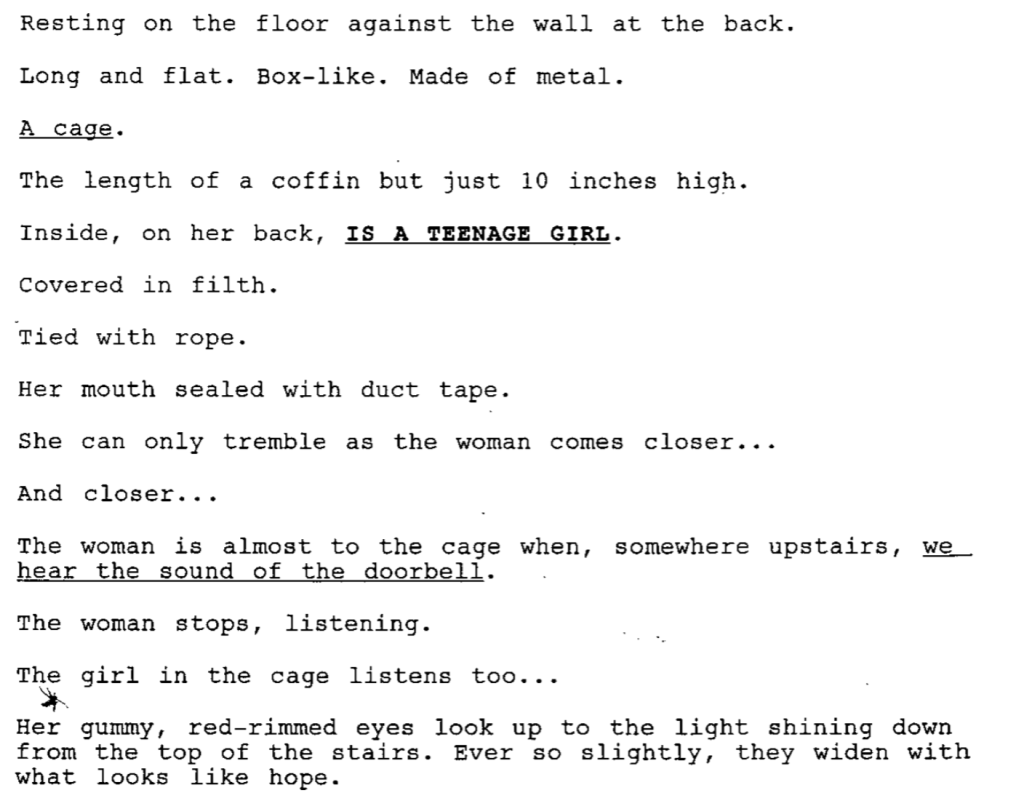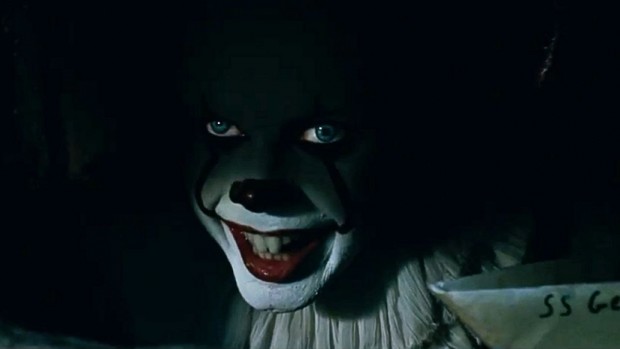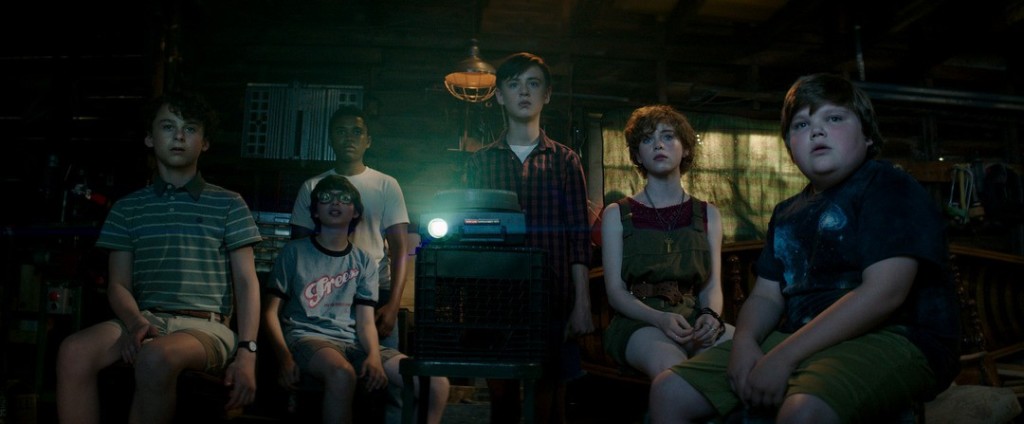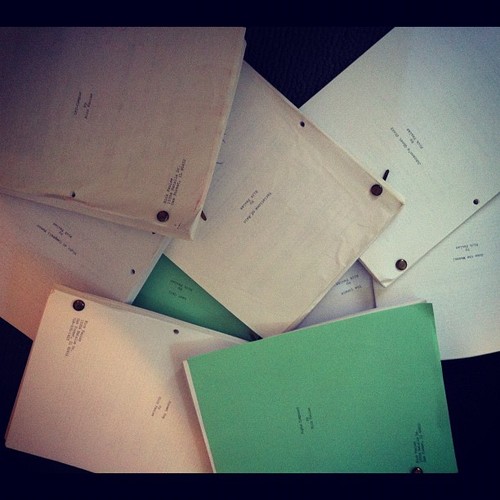Genre: Drama/Horror?
Premise: A man who’s lived his entire adult life in a mental institution obsessing over the beautiful niece he’s never met, finally decides to leave and find her.
About: Ted Foulke, aka Wentworth Miller, became a tour de force on the screenwriting circuit back in 2010, selling two scripts, Stoker and The Disappointments Room, back to back, winning over Hollywood with his sophisticated, intelligent, dark voice. Stoker became a huge project, attracting visionary South Korean director Chan-wook Park (Oldboy, Lady Vengeance, The Handmaiden). But something fell through the cracks during the adaptation, and the movie performed badly at the box office, disappearing out of the public eye almost immediately. The Disappointments Room, the more commercial of the two projects, didn’t fare much better, getting caught in the Relativity meltdown, ultimately dumped into the VOD market without any promotion. Today’s script, “Uncle Charlie,” is a prequel to Stoker.
Writer: Ted Foulke (Wentworth Miller)
Details: 119 pages
There was a good one year period there where Wentworth Miller was considered the best up-and-coming screenwriter in Hollywood. He wrote two specs, Stoker and The Disappointments Room, that wowed the shit out of anybody who read them. There was a depth and attention to detail that was absent from all the vapid empty scritps selling at the time, and just an interesting dark voice at the center of it all, giving us stories we’d never quite seen before.
But then the movies came out and they were… ignored. And I have a theory on that. Films that fall under the horror tag but don’t contain supernatural elements struggle to find an audience. There are exceptions to this. If the scripts have a big flashy hook (Get Out or The Purge), they can work. But if you have something like Stoker, where it isn’t 100% clear when you watch the trailer what genre we’re in or what kind of story we’re watching, that’s going to keep people out of the theater.
And the problem with Miller is that he actually makes his scripts intelligent. Which, funnily enough, alienates audiences even more. If he could just dumb it down a little (throw a killer clown in there), I’m sure he’d be one of the biggest horror screenwriters in town. I’d love to see a Miller supernatural horror film. I think it would be awesome. But for right now, we have his prequel to Stoker, Uncle Charlie. Let’s check it out.
“Uncle Charlie” starts out explaining that this a prequel to Stoker, and therefore if you don’t know that film, you won’t be able to appreciate this one. That’s a tricky choice because I don’t remember much about Stoker. But I do remember that a teenage girl named India loses her father and she and her mother move in with his mysterious brother, Uncle Charlie.
What we come to know later in the film is that Uncle Charlie has spent nearly his entire life in a mental institution. And that’s where we find Charlie here, a year before the events of Stoker, pulling off his best One Flew Over the Cuckoo’s Nest impression, wrecking havoc on his version of Miss. Ratchet, Doctor Walker. Charlie could’ve left this place years ago. He was actually able to leave the day he turned 18. But he CHOOSES to stay here.
When Charlie’s not making Doctor Walker’s life miserable, he’s drawing pictures of India. This part I didn’t understand. As far as I can tell, he’s never met India. So I don’t know how he can draw her so well. Maybe he’s seen pictures of her?
Meanwhile, back at the farm, India divides her time between going to school and taking piano lessons with her new teacher, Miss Price. Miss Price is an excellent teacher minus the fact that she moves from town to town, torturing and killing her students. In fact, she’s got one locked up in a cage in her basement right now. One that will have to be “taken care of” in order to make room for an unsuspecting India.
Over at the nut house, Uncle Charlie finally decides to flee the coup, illustriously turning Dr. Walker into a vegetable before doing so. And the first place he goes is India’s town. He’s got to meet his obsession, of course. He gets there right when India goes to her first high school dance. And let’s just say he “takes care” of India’s date so that she’s free.
That night, after the dance, India runs into Miss Price, who “happens” to be driving by, and who offers India a ride home. But, oh yes, she wants to stop by her house first to “show India something.” We all know where this is going. However, what Miss Price doesn’t know is that India’s got a new guardian angel. A very dangerous new guardian angel.
If yesterday’s prose annoyed you and you prefer a more classic writing style, this script is for you. Miller’s prose is simple, efficient, descriptive, and flows better than any script you’ll read this year. It’s what makes his scripts so easy to read, which, in this case, was necessary, since the story itself doesn’t stack up to his previous entries.
The problem is that Miller handcuffs himself with the prequel treatment. Prequels never work. Ever. I’m not sure why writers like them. They’re one giant narrative fork in the road where every path you take leads to a dead end. George Lucas painfully found this out when he started writing Episode 1. Wait, I have to keep two of my biggest characters, Obi-Wan Kenobi and R2-D2, apart for 99% of the trilogy?
Uncle Charlie follows two separate storylines, Uncle Charlie’s and India’s, and while these storylines want to find each other, or, at the very least, intersect, they can’t. Because in the next movie, Uncle Charlie and India meet for the first time. Miller tries. He tries his darndest, even cheats to give us that crossover moment. But the storylines never overlap in any meaningful way, which leaves the reader wondering, what was the point?
Another issue is that the script’s best plot thread, the serial killer piano teacher, is operating at a net negative. We know Miss Price can’t kill India because India appears in the next movie. And if you don’t have the uncertainty of whether India will succumb to this monster or not, where is the suspense? These movies only work if they’re suspenseful. So if your splashiest storyline can’t mine that tool, what’s the point?
You also run into issues like, what are the chances that so many killers are randomly intersecting in life? What are the chances that this girl has a serial killer uncle AND a serial killer piano teacher? Audiences start asking themselves these questions. And the answers are what break the suspension of disbelief.
“Uncle Charlie” also reminded me of a problem I had with Stoker. India isn’t an interesting character. I’ve told you guys this before. Be careful about making your main character a sociopath, eliminating all feeling and personality from them. These people walk around emotionless for 100 minutes, leaving the story feeling empty and cold whenever we’re around them. Miller tries to balance this out with the wackier more expressive Uncle Charlie, and it works to an extent. Uncle Charlie is a compelling character to watch. But like I said, the narrative is so handcuffed by its inability to intersect, it ultimately doesn’t matter.
“Uncle Charlie” is a fun and easy read for those who like reading scripts. But there’s neither a hook or a plot here that necessitates it becoming a movie. If Miller were to ever pursue this, it’d be in his best interest to eliminate the India side of the story and watch Uncle Charlie go off on some adventure. There are plenty of fun threads you could find there.
Old School Scriptshadow Script link: Uncle Charlie
[ ] What the hell did I just read?
[x] wasn’t for me
[ ] worth the read
[ ] impressive
[ ] genius
What I learned: Prose is simplicity. Miller is known for having some of the best prose in the business. But note how his description usually stays between 1-3 lines long. Note how he doesn’t use SAT words. Note how a lot of his prose breaks down to short fifth-grade level sentence structure. “Uncle Charlie” is right up there for you to download and see for yourself. A lot of beginner writers would do well to study it.
Say whaaaaat? Is this script actually better than the origin film of the franchise it’s joining?
Genre: Action/Thriller
Premise: A young girl with a proclivity for killing is recruited by a black ops government operation to be one of their primary assassins. But when she pisses off a group of fellow assassins, all hell breaks loose.
About: Shay Hatten burst onto the scene last year. The 22 year old, having just graduated from the underrated film school down at Loyola Marymount, made the Black List with his partially true depiction of Stephen King directing his first film, Maximum Overdrive. Hatten wasn’t done yet. He then wrote this script, which caught the attention of the hottest assassin franchise on the block, John Wick. The producers decided that Ballerina would be their first expansion of the John Wick universe. And so it came to be!
Writer: Shay Hatten
Details: 98 pages (undated)
The biggest spec trend by far at the moment is the Female John Wick trend. These juicy spec patties are selling with a side of fries at your local studio lot. Today it’s time for the Rolls Royce of this trend to make its debut on Scriptshadow – I’m talkin bout Ballerina. I mixed that car metaphor because this script so impressed the John Wick people, they’re actually integrating it into their John Wick universe! How can it get any more Female John Wick than that?
Not long ago, I reviewed Hatten’s breakthrough script, Maximum King, a project that was probably rushed into pre-production the second this weekend’s box office receipts came in. I didn’t love Maximum King. But Hatten can definitely write. He’s got a relentless energy to his prose and narrative, which means very little downtime for the reader. Which is not only the preferred mode for spec script writing, but an ideal mode for a spec like this. Are you as curious as I am with how he did? Then embrace the first position dammit, and straighten out your fucking tutu.
Rooney Brown (I wonder who Hatten envisions playing his lead) executes her first kill at age 6. Her father was in deep with some bad people, those people came to their house, and a crafty Rooney barreled into the killer’s legs once he reached the top of the stairs, sending him toppling down and cracking his neck.
Ever since then, the government’s been keeping an eye on Rooney, who uses the orphanage she’s sent to as her own personal training ground, splitting her time between beating up other kids and doing lots of one-armed push-ups.
Once she hits 18, Rooney is recruited by this black ops government dude named Berkowitz to be an assassin. Rooney doesn’t have a whole lot of direction in her life and she is good at beating the shit out of dudes much bigger than her, so why not?
She takes to killing easily, comfortable in the fact that she’s getting rid of bad dudes – dictators and the like. But then a couple of things change. Rooney falls in love and marries Tom. And the dudes she’s asked to kill aren’t always that evil anymore. It seems like she’s starting to kill only “kind of bad” dudes.
Rooney plans to get out. But not before this final job. While she’s poised to snipe some dude in a passing train, somebody else – another assassin! – snipes her! Injured, Rooney snipes back, killing the girl, and later Berkowitz admits that there’s a shady organization that sometimes kills his killers. Well that would’ve been nice to know ahead of time, Rooney points out.
What Rooney doesn’t know is that she’s just enacted the Defcon 5 protocol of an entire town full of killers. That’s right. There’s a place in the Swiss Alps called Sunnyvale that is made up entirely of killers, and they’ve been killing for over 500 years! Rooney just killed the leader’s daughter. Which means they want to get even. Rooney realizes that the only way she’s going to stop that is if she goes there first — and kills every single person in town.
Initial impressions? If Hatten keeps improving at this rate, he’s going to be one of the top 10 script doctors in Hollywood by the end of next year.
You know who he reminds me of? He’s kind of like Brian Duffield meets Max Landis. He’s got the relentless steamroll-the-page energy of Landis, peppered with some of that self-aware Duffield prose. Also, with this script, he’s starting to embrace character development. Watch out, Hollywood.
My issue with these scripts is always the same. The repetitive nature of the genre leads to boringness. There are only so many ways you can describe your assassin dodging a punch, shooting an enemy in the face, or threatening a baddie’s family unless they, “tell me what I need to know!”
As a result, these scripts tend to peter out by page 40. How do you avoid that? Well, Hatten’s crafted a solid blueprint.
You gotta make us care about the main character somehow. This is what’s going to pay all your dividends later. If you don’t pay attention to this part, your hero is going to feel generic. And audiences aren’t emotionally invested in whether generic soulless people get hurt or not.
You can achieve this “care” in one of two ways. The advanced way or the beginner way. Both ways work. One just takes more time.
The advanced way is to concoct a single scene that makes us fall in love with a character. The classic example of this is the opening scene of Indiana Jones. Indiana displays several things that make audiences fall in love with characters – intelligence, perseverance, and cleverness. The reason this is “advanced” is because it’s hard to make people fall in love with a character in 5-8 minutes. There aren’t many writers who can pull it off.
The beginner way is time. Dedicate a large segment of your first act getting to know your main character through their everyday life. Just the act of spending a lot of time with someone draws us closer to them and makes us care about them (no different from how we become close to people in real life).
Ballerina takes this route. We see Rooney when she’s a kid, as she grows up in an orphanage, as she’s recruited, when she falls in love, through a couple of assassinations – then, and only then, does the shit hit the fan. This way, when she’s going through scene number six of repetitive actions like, “…she kicks the cheese-maker in the face and jams a butter knife through his throat,” we still care, because we care about her.
The other way to keep these scripts interesting is to be unexpected. You have to make unexpected things happen in the micro and the macro. And when I say “unexpected,” I mean the type of shit that doesn’t USUALLY happen in these movies.
To give you an example of the micro, when Rooney is first attacked by that Sunnyvale assassin, she’s shot in her face. She sees the shot just before it comes so she’s able to pull her head back a little bit. But the bullet still goes through one cheek and out the other. This is unexpected in that, when I usually read these scripts, our hero will dodge the bullet entirely.
On the macro end, we have this Swiss Alps 500 year old Assassins Town. Of course I’ve seen a lot of mythology over the years when it comes to assassins. But I’ve never quite run into that. And this idea of our heroine going to a small town in the Swiss Alps to kill every single person in the town. I definitely haven’t seen that.
Writers are inherently lazy. They want to write the easy scene. I was actually going to review a different script today. It was an older script from a writer who was really big 7 years ago. He sold several specs. And I was curious why he’d disappeared off the face of the screenwriting planet.
So I read his “final” spec of that time. This script DID NOT sell. And that was the last time anyone heard from him. I swear to you, half of the first act was lifted directly from another famous movie. It wasn’t even sort of similar. It was the same series of events, beat for beat. I was appalled at the laziness. But I knew right then: THIS is why this writer isn’t working anymore. When you stop trying, the reader stops caring.
Anyway, I went on a little detour there. But the point I was making was, don’t get lazy. Always keep pushing yourself to come up with new scenes, new characters, new beats, new kills, new plot points. You’ll always be tempted to rip off your favorite scene from Aliens cause it’s right there! It’s so easy! Don’t do it. Find the new twist, the new unexpected beat. Keep doing that throughout the script and you’ll have something that feels like Ballerina. Familiar but fresh.
I was skeptical of this script going in. I thought it was going to be some half-assed John Wick wannabe. But it’s actually its own thing. And more importantly, it’s fun. You read this and you want to see the movie. And when it comes down to it, isn’t that all that matters with a spec?
[ ] What the hell did I just read?
[ ] wasn’t for me
[ ] worth the read
[x] impressive
[ ] genius
What I learned: When we try to make our hero “likable,” we often try and craft a single moment that’s going to make everyone fall in love with them. A typical example of this is your hero engaging in a mutually enjoyable conversation with a homeless person that lives outside their house. “Hey Mr. Atwood! Good to see you again!” “Leroy! How’s my man doing?” Look at how nice and cool our hero is that he engages with the homeless! I like him now! Wince. A more overlooked quality of likability, however, is perseverance. Audiences LOVE characters who never give up. It doesn’t matter how bad the situation is, that character is going to get out of it, dammit. So don’t always look for the quick fix. Sometimes the answer to solving your screenwriting problem takes place over the long-haul.
Genre: Event Horror
Premise: When a group of young kids begin seeing a demonic clown around their small town, they suspect he may have something to do with all the local kids who’ve gone missing over the years.
About: You’ll float too. After the chillingly bad TV movie version of “It,” in the 1990s, Stephen King’s most notorious novel was all but discarded as a vessel for adaptation. But in recent years, a King resurgence resulted in a newfound desire to produce a feature film based on the material. The problem was length. “It” is a huge book, 1489 pages, yet it wasn’t the kind of book you could build a trilogy around. Finally, someone came up with the genius idea to split the book in two – the children’s side and the adult side – and build a movie around both. This is the children’s side. And holy heck did it kick ass this weekend at the box office, pulling in $117 million, doubling the next highest horror opening of all time.
Writer: Chase Palmer & Cary Fukunaga and Gary Dauberman (based on the novel by Stephen King)
Details: 135 minutes
Let me start off by dispelling a myth Hollywood likes to propagate. “We’re putting out good movies. People just aren’t showing up.” That statement is nowhere close to true. For the past five years, Hollywood’s been upchucking retreads they only barely convinced us to see the first time around. They haven’t been trying for awhile now and the audience is calling them on it. You have to listen to your audience, Hollywood. They want something new. And in this case, they proved it. They wanted Event Horror.
So what is this thing I’ve been talking about all week that’s going to become the hot new thing? This “Event Horror?” How is Event Horror any different from Normal Horror?
To explain this, let’s go over the current Hollywood horror formula. Throw a group of characters into a single location (cabin, haunted house, deserted warehouse, woods), add scary element (monsters, ghosts, zombies, leprechauns), let the scares take place.
The reason this formula is rarrrrrely messed with is because it works for all three points on the triangle. Hollywood loves it because single location movies are cheap to produce. Writers like it because this is the preferred setup for building believable horror – locking characters into a location with nowhere to run. And audiences like it because the setup is inherently scary.
This is why “It” feels so different. It’s not just a bunch of one-dimensional characters packed into a haunted house. We’re getting to see these characters back in their homes, we’re getting to see them hang out together in their everyday lives. But, most importantly, we’re seeing an unrestrained group of characters. They can move about freely. It’s this “open-ended” character-driven adventure setup that makes this more of an “Event.” It feels bigger and less simplistic than your average horror movie. It’s horror opened up.
For those who haven’t seen the movie or read the book, “It” follows a group of 13 year old kids in the small town of Derry, in 1988 (updated from King’s original 1950s setting). The group leader is a kid named Bill who lost his kid brother, Georgie, to mysterious circumstances last year. Everyone else knows Georgie is dead. But Bill holds out hope that he’s still out there, along with all the other kids who have gone missing from Derry over the years.
One by one, Bill and the rest of the “Losers,” as they call themselves, are visited by a creepy clown who goes by the name, “Pennywise.” Pennywise performs a slightly different bag of tricks from your average clown. He eats children, as we (spoiler) see in the script’s nail-biting opening scene. Bill believes that Pennywise is holding Georgie hostage, and rallies the troops to infiltrate Pennywise’s domain and get Georgie back. But the kids realize that this… “It”… they’re dealing with is more powerful than anything they’ve ever dealt with in their lives.
Okay, now that I’ve emptied my book of praise all over the decision to make It, did the movie – and script – live up to the hype? It did. And that’s not to say there weren’t roadblocks along the way. In fact, the very thing that makes “It” different is what causes the writers so many problems. This results in a choppy narrative that was constantly in search of calmer seas.
What the hell are you talking about, Carson?
Earlier I was talking about the traditional horror film. For argument’s sake, we’ll call it the “cabin in the woods” scenario. Put a group of characters in a cabin in the woods, take away their car (it’s broken for whatever reason), unleash some evil entities on them, and you’ve got yourself a horror film.
In this scenario, coming up with scares is easy. The characters can’t go anywhere, so you just send monsters at them and they have no choice but to fight back.
Because “It” is open-ended and the characters aren’t restrained, the writers are constantly forced to come up with scenarios by which our heroes would willingly seek out dangerous situations. Either that or manufacture ways to get them into places where horror might occur, even if it doesn’t make a lick of sense.
For example, Ben (the “fat kid”), is reading at the library about the infamous Easter Massacre weekend in Derry 30 years ago where 100 people died. As he’s reading this, he spots a trail of flaming easter eggs that lead down to the basement. So Ben simply… FOLLOWS THE EGGS DOWN INTO THE BASEMENT. It’s here, of course, that he runs into a headless child and Pennywise the Clown. This is as manufactured as it gets. Nobody in their right mind would be dumb enough to do what Ben did. But the writers don’t have much choice. They have to push these characters into scary situations somehow.
Or Beverly, the lone girl in the group. There’s a scene where she gets home, goes to her bedroom, and a postcard Ben secretly planted in her bag pops out. On the back, Ben’s written her a 12 word poem. For some odd reason, Beverly rushes into her bathroom, locks the door, sits in her tub, and reads the poem. At the time I’m thinking, “Why is she going into the bathroom to read this? The poem isn’t War and Peace. It’s 4 lines long.” Then, as she’s reading it, something starts calling her from the sink. Ohhhhhhhhh, I realized. That’s why we had to manufacture this artificially closed-door bathroom scene. So something could attack her in the sink.
You see, this is why the “trapped” scenario is the preferred horror scenario to go with. You don’t have to force scary moments like this. They come to the characters organically.
Lucky for “It,” it has a trump card. Pennywise. This is easily the most iconic horror monster of the decade. He’s a perfectly crafted evil entity. So even when we do hit these manufactured scares, we forget about them the second Pennywise hits the screen because he’s so damn scary.
I have to give the producers props for casting relative unknown Bill Skarsgard. He’s so good in this. And the character creation and the make-up and the attention-to-detail (how the left eye is a little lazy). Wow. This is the kind of monster that will give kids nightmares for years. We can debate whether that’s a good thing or not in another post.
And the characters were great. To me, “It” is Stephen King’s magnum opus. Almost all of his characters in future books are variations on these characters. But these characters were the OGs. And the difference is, he really thought about these kids’ lives. Every kid here has a legitimately tense living situation at home that informs how they act in the outside world. I don’t think King ever tried as hard as he did with this group. And we’re the beneficiaries for it.
I felt that the plotting in the film was strong. The defining choice was having Bill search for his brother. That made sure that the characters were ACTIVE – that they were out there trying to achieve something. Without that, the characters are just waiting around for bad things to happen, and that’s where plots fall, where second acts deflate. So always make sure you’re injecting ACTIVE STORYLINES into your scripts, guys.
There’s a reason this movie made 117 million dollars this weekend. It was an event. It was a spectacle. It was more than your average horror offering. So I’m expecting this trend to pick up, hopefully extending into the spec market. It’d be nice to have another lane to sell scripts in other than biopics and female John Wicks.
[ ] What the hell did I just read?
[ ] wasn’t for me
[xx] worth the read
[ ] impressive
[ ] genius
What I learned: Sometimes, in order to find something original, you have to take a genre out of its comfort zone. Sure, horror works best in tight isolated locations where your characters can’t leave. But that’s also where everything’s been done before. Leave that setup behind to find new, potentially unknown, horror avenues to explore.
P.S. Stay tuned Thursday. I’m going to break down the rejected “It” script from Cary Fukunaga to see what they changed.
I don’t know about you guys, but I’m going to see “It!” this weekend. And since the film is already breaking records at the box office (and it’s only Friday!), screenwriters are going to want to get a jump start on the trend it’s going to spawn – Event Horror. The Tommyknockers will be coming soon (god I love that book). And then any scripts that can build a bigger world into the horror genre. I repeat, jump on the trend now! Cause soon it will be flooded.
How to play Amateur Offerings: Read as much of each script as you can and submit your winning vote in the comments section. Winner gets a script review next Friday!
If you’d like to submit your own script to compete on Amateur Offerings, send a PDF of your script to carsonreeves3@gmail.com with the title, genre, logline, and why you think your script should get a shot. Good luck!
Title: Nollywood
Genre: Dramedy
Logline: An up and coming director receives an opportunity to finally make her debut feature film; with one caveat, she only has one week to shoot. So, she makes the obvious decision – film the movie in Nollywood, Nigeria.
Why you should read: Yes, I understand people’s thoughts on movies about making movies, but this script being set in the bizarre and culturally different setting of Nollywood provides natural conflict as Merritt, the main character, has to learn to adapt and absorb a foreign culture. The speed and ways movies are made in the Nollywood system is inherently a fun experience, and the process accompanies by the people involved makes observing this mass difference between Hollywood and places where they seem to actually care and treasure movies that much more interesting.
Title: PARIS COUNTDOWN
Genre: Action
Logline: An Interpol narcotics agent is forced to team up with his hostile future father-inlaw, a CIA agent, to take down a criminal ring that has targeted Paris’ most valuable treasures.
Why you should read: It placed high: American Screenwriting competition Top 100, PAGE SEMI-FINALIST. It got a STRONG CONSIDER from a screenwriting service. It’s not the generic buddy movie. It has that “Meet the parents” vibe as a plus.
Title: In the Land of Tooth & Claw
Genre: Action/Adventure
Logline: A troubled professor recovering from familial tragedy is hired to help locate her ex-husband and mankind’s greatest discovery in the most dangerous environment recorded throughout history. The late Cretaceous – the land of tooth & claw.
Why should you read? I’d really like to provide some deep, nuanced answer here, but I can’t. Aside from those small, contained Jurassic Park movies, dinosaurs aren’t really a massive fixture on the big-screen (at least recently), which is weird given how innately cinematic they are. Thought i’d take a pop at addressing that. Honestly, I’ve worked hard on it and I think at the very least In the Land of Tooth & Claw is a fun read. Pretty brisk too. I’d obviously love to throw around descriptors like energetic, horrifying, resonant and imaginative, but that’s your job, not mine. Give it a shot, preferably with an alcoholic beverage, and see if you have a good time. That’s why I do this, anyway. To try and offer a little fun. The world’s pretty garbage sometimes, and dinosaurs join a select list (sex, chocolate and Tom Cruise flicks) that traditionally provide fleeting relief.
Title: EMILY VAN HELSING VS. DRACULA
Genre: Action-adventure
Logline: Young vampire hunter Emily Van Helsing must discover her full powers and true destiny in a quest to stop Dracula’s sinister plan to conquer Victorian London.
Why you should read: because it’s a fresh angle on the Van Helsing/Dracula mythology with a badass heroine. If you like your adventures in the gaslight and mist of Victorian London, this one is for you!
Title: Meat
Genre: Mystery/Horror
Logline: A misanthropic man notices bizarre changes in himself, his wife, and the animals inhabiting the territory around their homestead as they attempt to survive self-imposed isolation.
Why you should read: After moving from North Dakota post-college at the end of 2016, I started to write scripts in my spare time and fell in love with it. My first screenplay placed in the top 20% of the 2017 Nicholl fellowship, and as of now I’ve “finished” five features and am working on my sixth. I aim to create original, meaningful stories, but even more so focus on presenting them in a unique way. MEAT has been compared to The Witch by readers due to its low budget, as well as its setting and tone. It’s an unconventional horror story that poses a moral question without appearing pretentious.
Make sure to get those amateur entries in. There WILL be an Amateur Offerings this weekend. Title, Genre, Logline, Why We Should Read, plus a PDF of your script to carsonreeves3@gmail.com
Genre: Period
Premise: During World War 2, a famous Jewish director was coerced by the Nazis to produce a propaganda film showing the concentration camps as a spa for Jews, all while being a prisoner in one. Based on the true story of Kurt Gerron.
About: For the past seven years, I’ve been writing, directing and producing my own short films. Since my love for making movies is bigger than my wallet, I almost went bankrupt because of it. With that said, a year ago I wrote this screenplay after a FULL YEAR of research. The story is full of irony, and I never understood why no one had made a movie about Kurt yet.
Writer: Marcos Vaz
Details: 116 pages
It’s so great to hear that Marcos is out there doing exactly what I told you to consider at the end of yesterday’s article. Stop waiting for people to give you approval. Bypass the bullshit and be your own approval.
With that said, if this is Marcos’s plan for a first feature, I’d probably advise him to write a cheaper movie first. For those unfamiliar with budgets, any sort of period film is going to cost a lot of money, because you’re recreating a world that no longer exists. Old costumes, old props, old locations, old looks. That gets expensive fast.
However, this is obviously a passion project for Marcos and what I’ve found is that if you are going to make your own movie, intense passion will inspire others to join your cause. People will want to be a part of your movie and they’ll help you find ways to overcome financial restraints. That’s how a ton of movies get made.
So let’s see if the writing matches the passion here.
Kurt Gerron is a famous Jewish actor, writer, and most prominently, director. His plays are legendary. And he’ll be the first person to tell you that. This guy’s got one hell of an ego on him.
When Gerron and his wife, Olga, are rounded up by the Germans and sent to a concentration gamp in Czechoslovakia called Theresienstadt, they receive special treatment from the start. The head commander at Theresienstadt, Karl Rahm, is a huge Gerron fan. So, at first, things are going swimmingly.
Then Rahm gets word that the Red Cross will be visiting soon. They want to make sure that the Germans aren’t violating any human rights. He becomes concerned that nobody here looks happy (I wonder why). So he gets this idea: Have Gerron put on a play. People will have fun producing it. People will have fun watching it. It should lift the spirits of the camp so that everyone’s busting a gut by the time the Red Cross arrives.
Meanwhile, Rahm is putting together his own “play” – as in, he’s going to make the prisoners act like this place is a blast. He’s got scripts for the kids and the prisoners and the staff, who all must hit their marks, say the right things, smile and convince these pesky Red Crossers that everything is just wonderful.
Gerron speeds through pre-production but isn’t able to get a show together before the Red Cross arrives. Strangely, that turns out to be no problem, because the Red Cross found everything to be lovely, even going so far as to write a glowing letter that appeared in all of the world’s biggest newspapers.
Because things went so well, Rahm gives Gerron another task. He wants him to film a documentary of Theresienstadt and make it look like a vacation getaway. Gerron is thrilled that he still gets to put on a show and gets back to work.
Unfortunately, with the Russian army closing in and the end of the war nearing, Rahm is forced to ship as many Jews as possible to the killing camps, and Gerron ends up being one of those prisoners. In the end, he dies in the gas chambers of Aushwitz.
Okay Marcos. I’m going to get a little intense here. But it’s only because I see a lot of potential in this. Unfortunately, if we’re going to meet that potential, we’re going to need a page 1 rewrite. And that’s because the plotting is all over the place. The King’s Fool has no structure.
Gerron gets to this concentration camp and his mission is to produce a play that makes the prisoners happy so they won’t incite suspicion when the Red Cross arrives. This is a strange goal for a movie, since you’re basically building an objective that the audience wants the hero to fail at. If our hero succeeds, a camp full of Jews lives on in misery. Not exactly a situation to root for.
In addition to this, we have this odd secondary play going on where Rahm is directing all of the prisoners to follow a script for the Red Cross. I must have asked myself a thousand times, why wouldn’t you combine these two storylines into one and have Gerron be the one who’s directing the pretend happy camp?
Because clearly, Marcos had trouble plotting them both. First of all, the prisoners never got a chance to see the play! Which I thought was the whole point – they would see it, be happy, and that happiness would convince the Red Cross that everything was great. Instead, the Red Cross shows up, and decides everything’s great anyway. So then what was the point of the play plotline?
As if this wasn’t problematic enough, there were still 42 pages left in the script! And the main plotline was over! What do you do now? Marcos decides to introduce a new plot where Gerron is asked to direct a documentary of the camp. That becomes the driving force for the rest of the film.
Because this plotline comes on so late, it doesn’t have time to properly build. And by the time it does gain steam, we have to end it. Which puts a confused exclamation point on this structurally schizophrenic film.
I will say that I loved the moment in Aushwitz where he and his wife perform this dazzling scene for the camp, only for us to find out in the closing title cards that they were killed as soon as they got off the train. The problem was, it was so clumsy getting here that we can’t appreciate the greatness of this scene.
This goes back to advice I routinely give on the site yet still writers refuse to listen. Keep your story simple. The more you complicate things, the worse your script is going to get. Unless you’ve written 20 scripts and understand how complexity works in plotting, keep it simple.
Throughout The King’s Fool, it seemed like Marcos was in way over his head. If he just would’ve simplified the plot, he’d have been fine.
That plot needs to be one of two things. Either Gerron is the director for the “pretend happy camp” Rahm needs ready for the Red Cross. Or Gerron directs the documentary of the camp so that it looks like a vacation spa. One of those two is your movie right there. And it’s probably the second one.
Not only would this be good for the film’s structure, but it would allow us to add some heroism into the story.
In the current draft, we learn that the Russians are getting closer. You’ve also built up this death sentence storyline where anyone who gets on the transports is going to the death camps. You could easily work those two elements into a heroic moment for Gerron.
While shooting a scene, I could see him learn that 2000 prisoners are about to be sent away on the transports. Gerron storms out and insists that they bring the prisoners back. “I need them for extras. We have to make this look real.” And there’s this big hubbub where Rahm won’t budge and neither will Gerron, and finally Rahm relents, giving him his extras, and Gerron just saved 2000 people.
I don’t know if stuff like this happened of course. But you need to look for moments LIKE this. Where the main character actually does something heroic.
More importantly, though, the plot needs to be simplified. I do believe there’s a movie here. This is an interesting setup. But holy heck do we need a proper plot.
Script Link: The King’s Fool
[ ] What the hell did I just read?
[x] wasn’t for me
[ ] worth the read
[ ] impressive
[ ] genius
What I learned: You don’t want to have to restart your story on page 75. If you have to give your main character an entirely new goal at that point in the story, there’s probably something wrong with your structure.
What I learned 2: When you include singing in your script, make sure to italicize all of it to visually differentiate it from regular dialogue.

















